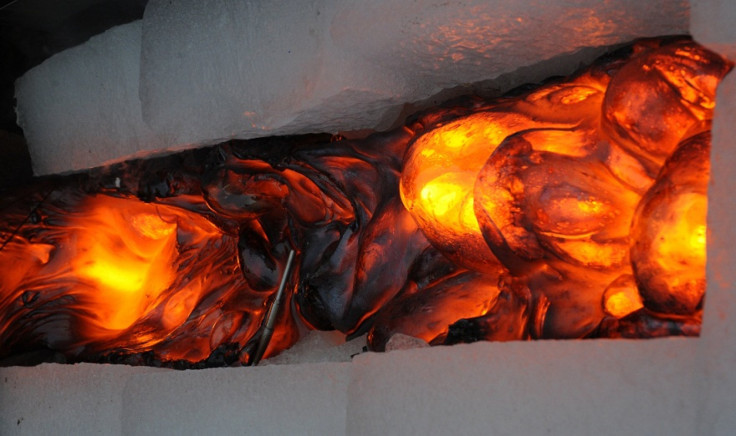A Song Of Ice And Fire Research: Scientists Pour Lava Over Ice To Study Snowy Volcanoes [VIDEO]

Some science experiments end in fire, and some end in ice -- and some, like those of the Syracuse University Lava Project, end with both.
There are actually hundreds of volcanoes on Earth with fiery hearts encased beneath ice and snow -- like the Icelandic volcano Eyjafjallajokull, which erupted in 2010. However, since many snow-covered volcanoes are often remote, scientists often don’t get to observe their eruptions.
So, if you can’t get to the volcano, why not make the volcano come to you? That's just what a group of scientists did in recent experiments described in the journal Geology. In order to create models of how snow-covered eruptions might behave, the Syracuse lava researchers, along with colleagues at Dickinson College, the Lamont-Doherty Earth Observatory, the University of Oregon and the University of Munich, have been making lava and pouring it onto slabs of ice. As this video of the experiments shows, the results are pretty fantastic:
Lava Pour No. 5 from robert wysocki on Vimeo
Lava, it turns out, doesn’t always just melt through ice. It can coast along the surface of an ice slab, thanks to a protective layer of steam, provided the ice is thick enough.
“The preliminary results of this study are both expected (ice melts!) and somewhat unexpected (lava can travel on top of snow; melted water can bubble up through lava),” the researchers said in a press release.
Plus, if the ice is covered with volcanic ash before an eruption occurs, lava is even less likely to melt through. The gray, sandy stuff acts to insulate ice and snow from lava flows.
"There are cases where blocks of snow have been preserved for decades, if not longer, in these kinds of conditions," coauthor Ben Edwards told National Geographic in May. "Once you get 5 to 10 centimeters of ash, it's a pretty effective blanket.”
Edwards and his colleagues said that the behavior of their manmade lava squares with observations from volcanic eruptions in both Iceland and Sicily, according to the researchers. Once lava does melt through a layer of ice, it can keep flowing underneath the ice layers, which may create characteristic formations. And sometimes the meltwater from lava pouring over snow creates a steamy river through the ice.
Studying snow-covered volcanoes can provide insights into previous ice ages and Earth’s climate history. Eruptions from sub-glacial volcanoes millions of years ago leave deposits behind that may be the only evidence for the presence of ice at the time.
SOURCE: Edwards et al. “Insights on lava-ice/snow interactions from large-scale basaltic melt experiments.” Geology published online 20 June 2013.
© Copyright IBTimes 2024. All rights reserved.





















